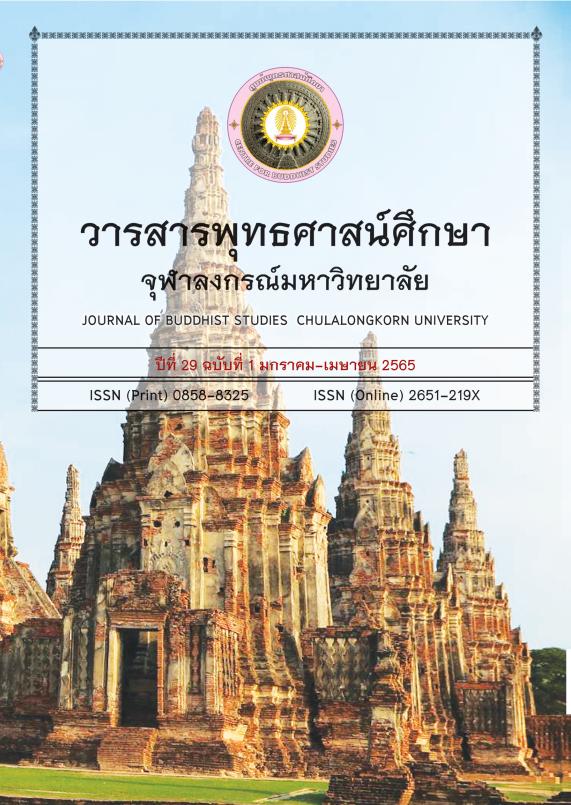The Thai Translation of the Biography of Kang Senghui in the Gaoseng zhuan (2)
Retribution for Sun Hao’s Disparaging Acts against the Buddha Image
Keywords:
Kang Senghui, Gaoseng zhuan, Sun HaoAbstract
The Gaoseng zhuan, or Lives of Eminent Monks, written around 530 A.D. by the monk Huijiao, is one of the most important works dealing with the history of Chinese Buddhism from 67-519 A.D. The scripture contains 257 biographies of prominent monks as well over 200 biographies of subordinate monks and upasakas. These biographies are divided into ten categories, the first of which – the one that contains 35 biographies of great contributors to translating the Sutra – Huijiao placed great emphasis on. The authors attempt to study one of the figures in this category, i.e. Kang Senghui, who lived in the Three Kingdoms period. Kang Senghui’s biography was detailed in the periods of two different rulers: 1) during the reign of Sun Quan, and 2) during the reign of Sun Hao.
In this paper, the authors focus on the study and translation of Kang Senghui’s biography during the reign of Sun Hao. The study finds that Kang Senghui faced a crisis because the court sought to suppress Buddhism which was slighted by Sun Hao. As a retribution for his disparaging acts against the Buddha Image, Sun Hao opened his mind to listen to Kang Senghui's sermon about the Law of Karma. He eventually became a supporter of Kang Senghui and Buddhism.
Downloads
References
เขมณัฏฐ์ ทรัพย์เกษมชัย. (ผู้แปล). (2557). ประวัติศาสตร์จีนฉบับย่อ (พิมพ์ครั้งที่ 2). กรุงเทพฯ: สำนักพิมพ์มติชน.
พระคลัง (หน), เจ้าพระยา. (ผู้แปล). (2559). สามก๊กฉบับเจ้าพระยาพระคลัง (หน). กรุงเทพฯ: สำนักพิมพ์อมรินทร์.
เมธี พิทักษ์ธีระธรรม, ปิยาภรณ์ ว่องวรางกูร, พรพิมล ศรีหมอก. (2563). ชีวประวัติ พระคังเซิงฮุ่ยในคัมภีร์เกาเซิงจ้วนแปล (1): การอัญเชิญพระบรมสารีริกธาตุ ของพระคังเซิงฮุ่ยในรัชสมัยพระเจ้าซุนกวนยุคสามก๊ก. วารสารพุทธศาสน์ ศึกษา จุฬาลงกรณ์มหาวิทยาลัย, ปีที่ 27 ฉบับที่ 2, 104-138.
ยง อิงคเวทย์. (2532). วิวัฒนาการกวีนิพนธ์จีน (ซือจิง: ฉู่ฉือ). กรุงเทพฯ: มูลนิธิเสถียร โกเศศ-นาคะประทีป.
สุวรรณา สถาอานันท์. (2555). หลุนอี่ว์: ขงจื่อสนทนา (พิมพ์ครั้งที่ 2). กรุงเทพฯ: สำนักพิมพ์ openbooks.
HIRAI, Shun'ei. (1993). 高僧伝の注釈的研究 III. 駒沢大学仏教学部論集 24, 1-36(L).
JIn Shu/56 (晉書巻56). (n.d.). Retrieved from https://zh.wikisource. org/ wiki/ 晉書/卷056
JIn Shu/57 (晉書巻57). (n.d.). Retrieved from https://zh.wikisource.org /wiki/晉書/卷057
JIn Shu/77 (晉書巻77). (n.d.). Retrieved from https://zh.wikisource.org/ wiki/晉書/卷077
JIn Shu/100 (晉書巻100). (n.d.). Retrieved from https://zh.wikisource.org/ wiki/晉書/卷100
KAMATA, Shigeo. (1982).中国仏教史 I. 東京: 東京大学出版会.
NAKAMURA, Hajime. (2003). 遊行経 上. 東京: 大蔵出版.
NATTIER, Jan. (2008). A Guide to the Earliest Chinese Buddhist Translation: Texts from the Eastern Han and Three Kingdoms Periods. Bibliotheca Philologica et Philosophica Buddhica 10. Tokyo: The International Research Institute for Advanced Buddhology.
ROBERT, Shih. (1968). Biographies des moines éminents (Kao seng tchouan) de Houei-kiao, Traduites et annotées. Louvain: Institut Orientaliste, Université de Louvain.
Sanguo Zhi/47 (三国志巻47). (n.d.). Retrieved from https://zh.wiki- source .org/wiki/三國志/卷47
Sanguo Zhi/64 (三国志巻64). (n.d.). Retrieved from https://zh.wiki- source.org/wiki/三國志/卷64
YOSHIKAWA, Tadao., and Toru, FUNAYAMA. (2009a). 高僧伝I. 東京: 岩波文庫.
YOSHIKAWA, Tadao., and Toru, FUNAYAMA. (2009b). 高僧伝II. 東京: 岩波文庫.
ZACCHETTI, Stefano. (2010a). Some Remarks on the Authorship and Chronology of the Yin Chi Ru Jing Zhu陰持入經註: The Second Phase in the Development of Early Chinese Buddhist Exegetical Literature. In Giacomella Orofino, & Silvio Vita (Eds.), Buddhist Asia 2: Papers from the Second Conference of Buddhist Studies Held in Naples in June 2004 (pp. 141-198). Kyoto: Italian School of East Asian Studies.
ZACCHETTI, Stefano. (2010b). The Nature of the Da Anban Shouyi Jing Reconsidered. Journal of the International Association of Buddhist Studies 32 (1-2): 421-484.
ZÜRCHER, Erik. (2007). The Buddhist Conquest of China: The Spread and Adaptation of Buddhism in Early Medieval China. Leiden: Brill.
Downloads
Published
How to Cite
Issue
Section
License
Copyright (c) 2022 Chulalongkorn University Centre for Buddhist Studies

This work is licensed under a Creative Commons Attribution-NonCommercial-NoDerivatives 4.0 International License.
บทความที่ได้รับการตีพิมพ์เป็นลิขสิทธิ์ของศูนย์พุทธศาสน์ จุฬาลงกรณ์มหาวิทยาลัย
ข้อความที่ปรากฏในบทความแต่ละเรื่องในวารสารวิชาการเล่มนี้เป็นความคิดเห็นส่วนตัวของผู้เขียนแต่ละท่านไม่เกี่ยวข้องกับศูนย์พุทธศาสน์ จุฬาลงกรณ์มหาวิทยาลัย และคณาจารย์ท่านอื่นๆในมหาวิทยาลัยฯ แต่อย่างใด ความรับผิดชอบองค์ประกอบทั้งหมดของบทความแต่ละเรื่องเป็นของผู้เขียนแต่ละท่าน หากมีความผิดพลาดใดๆ ผู้เขียนแต่ละท่านจะรับผิดชอบบทความของตนเองแต่ผู้เดียว






